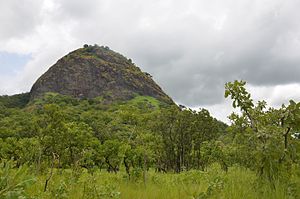Fazao-Malfakassa National Park
|
Fazao-Malfakassa National Park
|
|
|
Mountain in the Fazao Forest |
|
| location | Togo |
| surface | 1920 km² |
| WDPA ID | 2340 |
| Geographical location | 9 ° 0 ′ N , 1 ° 0 ′ E |
| Setup date | 1975 |
| administration | Franz Weber Foundation |
The Fazao-Malfakassa National Park , also Fazao-Melfacassa National Park, is a national park near Sokodé in the west of the Centrale region in Togo near the border with Ghana . It was created in 1975 by merging the forests of Fazao with 1620 km² and Malfakassa with 300 km², which have been protected since 1951, and is on the tentative list of the World Heritage Committee .
geography
It is 1920 km² and is 100 to 800 m above sea level on the Atakora mountain range . In the north are the Monts de Malfakassa , in the center the Monts du Fazao with their steep cliffs, the Falaise de Boulowou , along the western ridge. Fazao-Malfakassa National Park is the only national park in West Africa with such features.
Climate and vegetation
The annual precipitation is 1200 mm. The diverse vegetation includes tree savannah with communities of Afzelia africana , Anogeissus leiocarpa and Isoberlinia doka or Monotes kerstingii and Uapaca togoensis , gallery forest from Dialium guineense , Antiaris africana and Berlinia grandiflora , submontane forest and grass-covered mountain peaks. Forests make up 97% and shrubland 1% of the park.
fauna
Here live lions , leopards , wild dogs and several species of monkeys. Buffalo , cob antelopes , bongos and sitatungas are found on horned bearers . The number of elephants and their chances of survival are unknown. There are also cheetahs (albeit few), many primates (including chimpanzees), reptiles, birds and other animals.
Birds
The national park is one of the few places in Togo where the northern ground hornbill occurs. It is a refuge for many rare birds of prey such as Hieraaetus dubius and Spizaetus africanus , but also for the guinea fowl Guttera pucherani and the Frankolin Francolinus lathami . Many unrecorded species are likely to live in the area, especially in the densely forested valleys of the Kpaza and Koué rivers. The national park is one of the four Important Bird Areas in Togo, which together cover 5085 km², i.e. 9.4% of the country's area.
Exposure and Management
After the political upheavals of the early 1990s, the national park suffered from increased poaching. Other threats include illegal gold mining, which is destroying river basins such as the Loukoulou, as well as illegal honey gathering and a plan to build a road through the park to Ghana. In 1990 the F. Weber Foundation signed an agreement with the government of Togo to manage the national park and the hotel belonging to it for 25 years. To combat poaching, the Fondation purchased a light, low-noise aircraft and commissioned a pilot to search the vast area for poachers.
tourism
Safari tours are offered in the dry season from November to April. The hotel "Parc Fazao", which was supposed to help secure the livelihood of the large village community of Fazao, was reopened in November 2000 after a complete renovation. However, the Hotel Parc Fazao has been closed again since the beginning of 2001.
literature
- Wally and Horst Hagen: The African national parks as habitats for elephants . In: Vitus B. Dröscher (1990): Save the Elephants of Africa (p. 221)
Web links
- Profile at BirdLife; contains a list of birds in the national park
- Tourism
- Fight against poaching, hotel "Parc Fazao", elephants in the national park
Individual evidence
- ↑ Parks and protected areas in Togo (English)
- ↑ World Heritage in Africa including tentative list (English) ( page no longer available , search in web archives ) Info: The link was automatically marked as defective. Please check the link according to the instructions and then remove this notice.
- ↑ Acinonyx jubatus ssp. hecki on the IUCN Red List of Threatened Species .
- ↑ Togo as a travel destination (English) ( Memento of the original from February 9, 2010 in the Internet Archive ) Info: The archive link was automatically inserted and not yet checked. Please check the original and archive link according to the instructions and then remove this notice.
- ↑ Important Bird Areas in Togo (English) ( Memento of the original from June 16, 2010 in the Internet Archive ) Info: The archive link has been inserted automatically and has not yet been checked. Please check the original and archive link according to the instructions and then remove this notice.
- ↑ This information comes from the hotel information Togo since April 2001, from the personal inspection of the hotel in September 2010 and information from the employees of the Franz Weber Foundation in Sokodé, September 2010 and December 2012.

